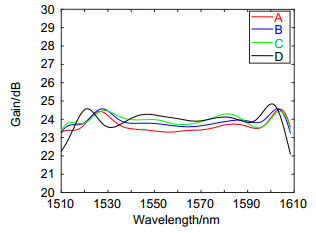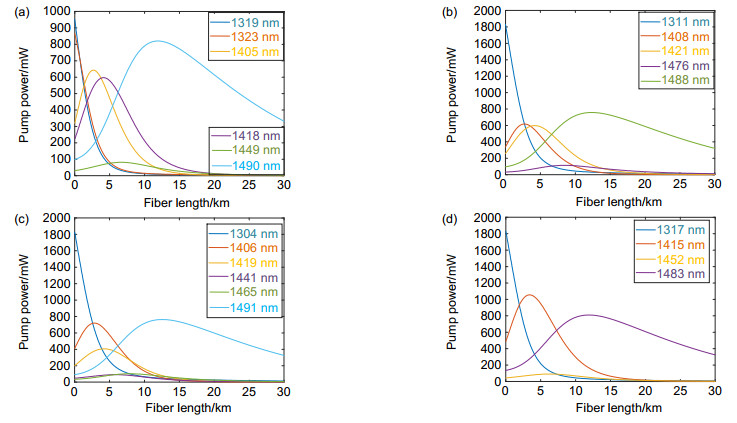Research on second-order Raman fiber amplifier based on particle swarm optimization
-
摘要
为了进一步提升二阶拉曼光纤放大器(RFA)的性能指标,对二阶RFA的主要参数进行了分析。首先设计了一个可以通过光开关控制,在二阶和一阶RFA两种模式下切换的结构模型,通过模拟仿真证明了二阶RFA可以提高系统的增益,改善系统的噪声性能,然后针对二阶RFA的增益性能进行了优化,以降低平坦度为优化目标,使用粒子群算法优化泵浦光波长和功率的配置,再经过结构的改进,最终在100 nm带宽范围内实现了增益为24.50 dB,增益平坦度为0.98 dB的二阶RFA。这些结果为以后设计出性能更加完善的二阶RFA提供了参考。

Abstract
In order to further improve the performance index of second-order Raman fiber amplifier, the main parameters of second-order RFA were analyzed. First, a structural model that can be controlled by optical switches and switched between two modes of traditional second-order and traditional first-order RFA is designed. It is proved through simulation that second-order RFA can increase the system gain and improve noise performance. The gain performance of first-order RFA is optimized. The optimization goal is to reduce the flatness. The particle swarm optimization algorithm is used to optimize the configuration of the wavelength and power of the pump light. After further structural improvement, a second-order RFA with a gain of 24.50 dB and a gain flatness of 0.98 dB were achieved in a 100 nm bandwidth. These results provide a reference for the design of second-order RFA with better performance in the future.
-
Key words:
- Raman fiber amplifier /
- second-order pump /
- gain /
- flatness /
- particle swarm optimization
-
Overview

Overview: With its own advantages, RFA has gradually occupied an increasingly important position in the optical fiber communication systems. The current research on RFA is still focused on traditional first-order RFA. During the continuous development of optical amplifier technology, the performance of other types of optical amplifiers has also in the gradual improvement. Facing such a competitive trend, people's eyes are gradually turning to higher-order Raman amplifiers. In the high-level, people first put research hotspots into the second-order RFA research and development, and experiments. How to increase the output bandwidth of RFA and reduce its gain flatness is an important problem to be solved by current amplifiers. In this paper, a second-order forward multi-pumped FRA is used, and pumps with different wavelengths have different gain peak amplification for different frequency signals, so as to achieve amplification of the entire band of signal light. First, it is proved through simulation that the second-order RFA can increase the system's gain and improve the noise performance of the system. Then, the second-order RFA's gain performance is optimized. The output gain and gain flatness are taken as the optimization goals within the 100 nm bandwidth. The particle swarm optimization algorithm is used to optimize the configuration of the wavelength and power of the pump light, so that the first- and second-order pump light interact to realize the multi-pump technology to reduce the flatness and improve the performance of the second-order RFA. In the analysis of the optimization results of the particle swarm optimization algorithm, a simpler and more efficient second-order RFA structure is given through the data summary and comparison, and the structure optimization of the second-order RFA is realized. In the optimized structure, the optimal configuration of the pump light wavelength and power of the second-order RFA is also given through continuous search and optimization of the algorithm. In addition, a single second-order pump and five first-order pumps used in the 100 nm bandwidth realized the second-order RFA with gain of 24.50 dB and gain flatness of 0.98 dB, which proved the effectiveness of the particle swarm optimization algorithm in optimizing the gain performance of the second-order RFA. Finally, the effect of the number of pump light on the performance of the second-order RFA is analyzed. It is concluded that the number of first-order pump light has a great effect on improving the flatness of the gain. These results provide a reference for the design of the second-order RFA with better performance in the future.
-

-
表 1 优化结果
Table 1. Optimization results
No. Gain/dB ⊿/dB 2nd-order pumps 1st-order pumps λ/nm P/mW λ/nm P/mW A 24.56 1.20 1319/1323 952/866 1405/1418/1449/1490 320/222/31/98 B 24.61 1.25 1311 1830 1408/1421/1476/1488 337/257/32/95 C 24.50 0.98 1304 1821 1406/1419/1441/1465/1491 410/201/48/35/91 D 24.75 2.73 1317 1849 1415/1452/1483 487/43/135 -
参考文献
[1] Kidorf H, Rottwitt K, Nissov M, et al. Pump interactions in a 100 nm bandwidth Raman amplifier[J]. IEEE Photonics Technology Letters, 1999, 11(5): 530-532. doi: 10.1109/68.759388
[2] Gainov V, Gurkin N, Lukinih S, et al. Record 500 km unrepeatered 1 Tbit/s (10x100G) transmission over an ultra-low loss fiber[J]. Optics Express, 2014, 22(19): 22308-22313. doi: 10.1364/OE.22.022308
[3] Zhu B Y, Borel P, Carlson K, et al. Unrepeatered Transmission of 6.3 Tb/s (63x128 Gb/s) Over 402-km Fiber Link[J]. IEEE Photonics Technology Letters, 2014, 26(17): 1711-1714. doi: 10.1109/LPT.2014.2331338
[4] 周文婷, 崔力民, 张玮, 等.超长距光传输系统中光放大器综合配置技术研究[J].电子器件, 2016, 39(6): 1360-1363. doi: 10.3969/j.issn.1005-9490.2016.06.016
Zhou W T, Cui L M, Zhang W, et al. Study on integrated configuration of optical amplifiers in the ultra long haul optical transmission system[J]. Chinese Journal of Electron Devices, 2016, 39(6): 1360-1363. doi: 10.3969/j.issn.1005-9490.2016.06.016
[5] 方音佳, 赵蕊月.拉曼光纤放大器的发展现状[J].科技创新与应用, 2018(19): 76-77. http://www.cnki.com.cn/Article/CJFDTotal-CXYY201819032.htm
Fang Y J, Zhao R Y. Development status of Raman fiber amplifier[J]. Technology Innovation and Application, 2018(19): 76-77. http://www.cnki.com.cn/Article/CJFDTotal-CXYY201819032.htm
[6] 臧可.高阶光纤拉曼放大器的特性研究[D].北京: 北京邮电大学, 2013.
Zang K. Research on the characteristics of the Higher-order Raman fiber amplifier[D]. Beijing: Beijing University of Posts and Telecommunications, 2013.
[7] 黄金飞, 付成鹏, 余春平.二阶DRA泵浦方式对噪声性能的影响[J].光通信研究, 2016(5): 62-64. doi: 10.13756/j.gtxyj.2016.05.018
Huang J F, Fu C P, Yu C P. The effect of second order DRA pumping way on the performance of the noise[J]. Study on Optical Communications, 2016(5): 62-64. doi: 10.13756/j.gtxyj.2016.05.018
[8] Chen Y F. Improved energy detector for random signals in Gaussian noise[J]. IEEE Transactions on Wireless Communications, 2010, 9(2): 558-563. doi: 10.1109/TWC.2010.5403535
[9] 王丹燕, 姜海明, 谢康.双向多泵浦光纤拉曼放大器偏振相关增益研究[J].红外与激光工程, 2016, 45(2): 0222003. doi: 10.3788/IRLA201645.0222003
Wang D Y, Jiang H M, Xie K. Study on polarization dependent gain of fiber Raman amplifiers with bidirectional pumps[J]. Infrared and Laser Engineering, 2016, 45(2): 0222003. doi: 10.3788/IRLA201645.0222003
[10] Al-Asadi H A, Hambali N A M B A. Experimental evaluation and theoretical investigations of fiber Raman amplifiers and its gain optimization based on single forward pump[J]. Journal of Laser Applications, 2014, 26(4): 042002. doi: 10.2351/1.4889955
[11] 杨伟新, 张晓森.粒子群优化算法综述[J].甘肃科技, 2012, 28(5): 88-92, 73. doi: 10.3969/j.issn.1000-0952.2012.05.033
Yang W X, Zhang X S. Overview of particle swarm optimization algorithms[J]. Gansu Science and Technology, 2012, 28(5): 88-92, 73. doi: 10.3969/j.issn.1000-0952.2012.05.033
[12] 徐鹤鸣.多目标粒子群优化算法的研究[D].上海: 上海交通大学, 2013.
Xu H M. Research on multiobjective particle swarm optimization algorithms[D]. Shanghai: Shanghai Jiao Tong University, 2013.
[13] 冯金芝, 陈兴, 郑松林.一种改进的多目标粒子群优化算法及其应用[J].计算机应用研究, 2014, 31(3): 675-678, 683. doi: 10.3969/j.issn.1001-3695.2014.03.008
Feng J Z, Chen X, Zheng S L. Improved MOPSO algorithm and its application[J]. Application Research of Computers, 2014, 31(3): 675-678, 683. doi: 10.3969/j.issn.1001-3695.2014.03.008
[14] Gong J M, Ding Z, Li S P, et al. Research on broadband raman fiber amplifier based on particle swarm optimization[J]. Study on Optical Communications, 2018, 44(5): 46-51, 68. http://en.cnki.com.cn/Article_en/CJFDTotal-GTXY201805009.htm
-
访问统计


 E-mail Alert
E-mail Alert RSS
RSS

 下载:
下载:










